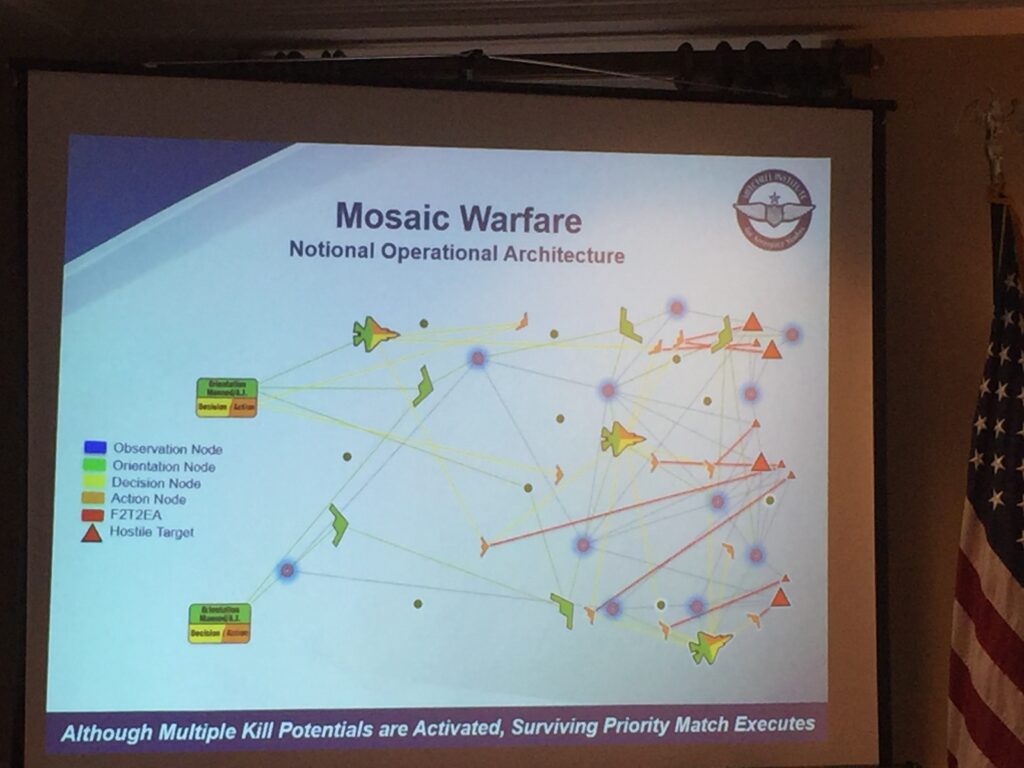By THERESA HITCHENS
Timothy Grayson, director of DARPA’s Strategic Technologies Office
 WASHINGTON: Just when you thought you understood Multi-Domain Operations (MDO), along comes the Defense Advanced Research Projects Agency’s “Mosaic Warfare.” It’s sort of MDO on steroids: an all-encompassing ‘force design’ — that includes everything from military organization to operational concepts to weapon systems to tactics — to underpin a new US way of war targeted at blocking China’s strategy of hitting critical US information nodes. Oh, and the technologies required to accomplish that force design.
WASHINGTON: Just when you thought you understood Multi-Domain Operations (MDO), along comes the Defense Advanced Research Projects Agency’s “Mosaic Warfare.” It’s sort of MDO on steroids: an all-encompassing ‘force design’ — that includes everything from military organization to operational concepts to weapon systems to tactics — to underpin a new US way of war targeted at blocking China’s strategy of hitting critical US information nodes. Oh, and the technologies required to accomplish that force design.
“Kill webs,” not kill chains. Instead of exquisite platforms like the F-35 fighter, exquisite functional technology nodes (such as an advanced infrared sensor) that can be mixed and matched via AI-enhanced networks. A battle plan that doesn’t exist until a field commander builds it, based on whichever capabilities are available in real time — like a kid building a LEGO spaceship not from a kit and a blueprint, but from a drawer of jumbled pieces that nonetheless all fit together.
Timothy Grayson, director of DARPA’s Strategic Technologies Office (STO), said today at a Mitchell Institute meeting that Mosaic Warfare is a “system of systems” approach to warfighting designed around compatible “tiles” of capabilities (think functions such as sensors and shooters), rather than uniquely shaped “puzzle pieces” (think platforms) that must be fitted into a specific slot in a battle plan in order for it to work.
Air Force Lt. Col. Dan Javorsek, a program manager at STO, told me after the conference that currently a force planner works to optimize “what’s best for the F-22” fighter in an operation, whereas under the Mosaic concept that planner would be focused on what role the F-22 and its multiple subsystems could best play in the battle. Javorsek, whose call sign is Animal, is a former F-22 test pilot.
In an email asking for an explanation of the difference between Mosaic Warfare and MDO, Grayson explained Mosaic Warfare is “very complementary” to the Multi-Domain Battle (MDB, older Army lingo) and MDO (current Army and Air Force lingo) concepts “in that it is based upon the same principles of a mission-centered capability, but Mosaic is providing technology and infrastructure to give MDB more options, composed faster.”
MDB, he said, “is mostly a doctrinal concept and is doing innovative things with tactics and force structure, but MDB force planners are limited in their options. For example, they cannot create a new materiel capability when systems and new technology have not already been integrated, and they can’t readily deal with changing human-based capabilities, because we have static fundamental units of action. (For example a rifle company really only has one capability, an infantry assault.)”
For a half century, DRS has provided military forces around the world with advanced technologies and capabilities to meet their mission needs. Here are some highlights.
From LEONARDO DRS
Grayson added: “Mosaic tools and infrastructure equip the MDB force/mission planner with more options to choose from by enabling machine-to-machine integration closer to mission planning time, as well as definition of new hybrid forces. It automates and abstracts away a lot of the complexity that prohibits this today. The result is the ability for a MDB force/mission planner to tailor a capability that is much more effective and efficient at addressing a specific clear and present mission need.”
Key to the concept, Grayson told the Mitchell Institute audience, is flexibility. “What we are trying to do … is to enable the ability to create what I’ll call a warfighting architecture, which would be a force package … [and] to be able to defer the decision as to what that warfighting architecture is going to be to as close as possible to time of need,” Grayson said. “How do we build the technologies and infrastructure to enable the actual operators to make decisions” about what he needs to accomplish the mission.
The Mosaic Warfare concept has been tumbling around DARPA since 2017, but is beginning to manifest in a series of studies and DARPA’s “portfolio” of related technology programs, led by their Strategic Technologies Office (STO). One of those technologies, Grayson told me, is the System of Systems Integration Technology and Experimentation (SoSIT) — known as STITCHES and demonstrated last July by Lockheed Martin — that can translate and transmit data between otherwise inoperable legacy ground stations and platforms.
The Mitchell Institute’s study released today, “Restoring America’s Military Competitiveness: Mosaic Warfare,” is one of the first to be finished. It seeks to define the concept and recommend steps to implement it.

Mitchell Institute’s proposed notional architecture for Mosaic Warfare
“There is no other option at this point,” explains Todd Harrison, the director of the Aerospace Security Project at the Center for Strategic and International Studies (CSIS). “The Air Force needs new tankers, and Boeing is the only one making them.”
“In the Mosaic concept, platforms are ‘decomposed’ into their smallest practical functions, creating collaborative ‘nodes’ in a networked kill web that is highly resilient, and can remain operationally effective even if an adversary destroys some of it,” explained David Deptula, Mitchell’s dean, and a member of the Breaking Defense Board of Contributors..
On Aug. 7, STO held its first industry day focused on “Mosaic Technologies” (followed by a classified day on Aug. 8) calling on interested vendors to put forward “innovative ideas and disruptive technologies that provide the U.S. military increased lethality in an era of eroding dominance.” The STO announcement said that “It is the disaggregation of effects chain functions (e.g., Find, Fix, Target, Track, Engage, and Assess or F2T2EA) across a heterogeneous mix of manned and unmanned platforms from all domains. Furthermore, it is the ability to compose and recompose effects chains at high speed without a priori knowledge of which systems will provide which function(s) of a given effects chain.”
The Mitchell Institute study argues that “DoD cannot simply focus on building a better mousetrap.” Indeed, the study practically thunders, the US military is doomed to future defeat if it does not resolve these critical gaps:
Small inventories of quite capable, high-end multifunction platforms in the current force make U.S. operational architectures too vulnerable.
The practice of buying multiple kinds of high-end weapon systems in limited numbers is inefficient and does not provide the force capacity needed for great power conflict.
It takes too long to develop and field major new weapon systems.
America’s current force design cannot appropriately scale across the spectrum of conflict.
Critical elements of current US force design cannot withstand attrition, and survivability factors threaten to outweigh the ability to create effects in the modern, complex wartime environment.”
“In particular, the United States must address the burgeoning threat that China poses and the way it has carefully designed its system warfare strategy to counter America’s traditional way of war,” wrote Deptula and his fellow authors. “By targeting US data links, disrupting information flows, denying command and control, and kinetically targeting physical nodes of the US information system, China is planning systematically to blind US commanders and paralyze their operations.”
Mosaic Warfare could resolve all of these problems, the study asserts. However, new investments in enabling technologies are required — technologies that the DARPA portfolio of programs is exploring. These include basic “planning technologies” all the way up to sophisticated, spoof-proof artificial intelligence networks to sift through incoming sensor data.
While there is a widespread recognition of the problems the Mosaic Warfare concept supposedly could fix, there is not widespread agreement about how to solve them. For example, while the Army and the Air Force have enthusiastically embraced the Multi-Domain Operations concept, the Navy remains skittish.
“Implementing a mosaic force design will challenge issues of doctrine, tradition, parochialism, bureaucratic fiefdoms, and even the pride of victories past,” the Mitchell study notes.
That said, the study also argues that the Air Force “is perhaps the best candidate (emphasis added) to take a lead role in developing a mosaic force design concept that could reshape DoD’s planning, processes force structure and how it executives its missions.” The Air Force has been asserting a prime roll as the MDO “quarterback” via its developing Multi-Domain Command and Control (MDC2) network, and the Mitchell Institute, after all, is an organization whose mission is in part to promote the role of aerospace power.
No comments:
Post a Comment